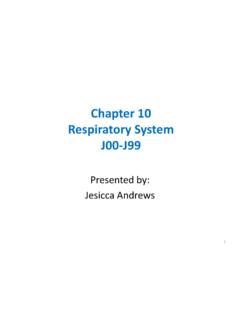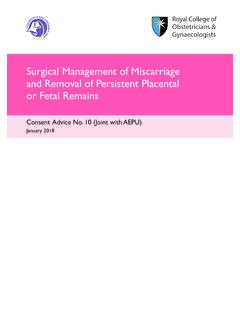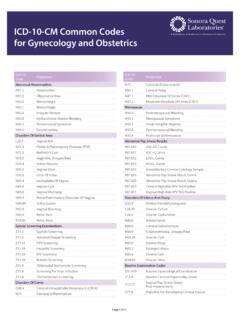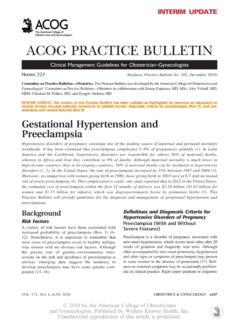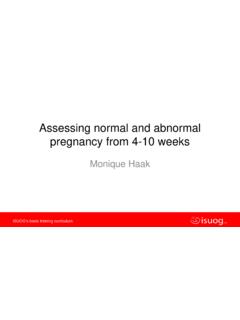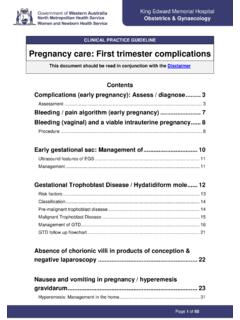Transcription of CHAPTER 15 PREGNANCY, CHILDBIRTH, AND THE …
1 CHAPTER 15. PREGNANCY, CHILDBIRTH, AND. THE PUERPERIUM. O00-O9A. Presented by Jennifer Kurkulonis 1. LEARNING OUTCOMES. Code complications of pregnancy using the proper fourth and fifth characters. Use the proper Z codes to assign the outcome of delivery. Code for other obstetric care besides childbirth. Code for contraceptive and procreative management. Codes from CHAPTER 15 take precedence over codes from other chapters. Codes from CHAPTER 15 are never assigned on the newborn record. 2. Female Reproductive System 3. TERMS TO KNOW. Antepartum - the period of pregnancy from conception to childbirth Peripartum - the period involving the last month of pregnancy to five months postpartum Postpartum the period beginning right after delivery and including the next six weeks Puerperium the clinical term for the postpartum period 4. PREGNANCY. O00-O08 Pregnancy with abortive outcome (tubals, spontaneous abortion, TOP).
2 O09 Supervision of high risk pregnancy O10-O16 Edema, proteinuria, hypertensive disorders O20-O29 Other maternal disorders O30-O48 Maternal care related to the fetus, amniotic cavity and possible delivery problems O60-O77 Complications of L&D. O80, O82 Encounter for delivery O85-O92 Complications related to the puerperium O94-O9A Other obstetrical conditions NEC. 5. Supervision of Normal Pregnancy Z34. 4th Character Subcategory 5th Character Subcategory .0 First Pregnancy 0 Unspecified Trimester .8 Other Pregnancy 1 First Trimester .9 Unspecified Pregnancy 2 Second Trimester 3 Third Trimester Trimester time frames: First trimester - less than 14 weeks 0 days Second trimester - 14 weeks 0 days to less than 28. weeks 0 days Third trimester - 28 weeks 0 days until delivery 6. Supervision of High Risk Pregnancy O09. infertility (history of).
3 Ectopic or molar pregnancy (history of). other poor reproductive or obstetric history - Insufficient antenatal care (current pregnancy). - Grand multiparity (has given birth five or more times). - Elderly (pregnancy for female 35 years and older at expected date of delivery) primigravida and multigravida - Young (pregnancy for a female less than 16 years old at expected date of delivery) primigravida and multigravida - Due to social problems - Supervision of other high-risk pregnancies (includes pregnancy resulting from assisted reproductive technology [ ] and pregnancy with history of in utero procedure during previous pregnancy [ ]). Codes from category O09 all require a 5th or 6th character to identify trimester. 7. Weeks Gestation Z3A. 5th character codes the 4th & 5th characters represent the number of weeks gestation as they are written.
4 ICD-10 instructs the coder to use an additional code from category Z3A to identify the specific week of the pregnancy . For weeks 8 42: With the exception of: 8 weeks gestation unspecified weeks 9 weeks gestation less than 8 weeks 10 weeks gestation greater than 42 weeks 11 weeks gestation 12 weeks gestation Codes from category Z3A are for use only on the mother's record. 8. Exercise 1. Pregnancy at 43 weeks of gestation 2. Office visit for routine prenatal care, for primigravida (first pregnancy) patient with no complications, 37. completed weeks 3. Office visit for care of 40-year-old patient who is in the 2nd trimester of her third pregnancy (multigravida). 9. Exercise Answers 1. 43 weeks of gestation + 2. Office visit for routine prenatal care, for primigravida (first pregnancy) patient with no complications, 37. completed weeks + 3.
5 Office visit for care of 40-year-old patient who is in the 2nd trimester of her third pregnancy (multigravida). + 10. Pre-existing HTN, HTN Heart Disease, CKD. O10. Hypertension in pregnancy is always considered a complicating factor in pregnancy, childbirth, or the puerperium. Determine whether the hypertension is a pre-existing or gestational . Pre-existing hypertension is classified to category O10. Essential hypertension Hypertensive heart disease Hypertensive chronic kidney disease Hypertensive heart and chronic kidney disease Secondary hypertension Unspecified When assigning one of the O10 codes that includes hypertensive heart disease or hypertensive chronic kidney disease, it is necessary to add a secondary code from the appropriate hypertension category to specify the type of: hypertensive heart disease (category I11). heart failure (category I50).
6 Chronic kidney disease (category I12). hypertensive heart and chronic kidney disease (category I13). 11. HTN and Preclampsia O11,O13,O14. O13 - Gestational Hypertension without significant proteinuria. Patients may develop transient, gestational or pregnancy-induced hypertension during pregnancy. This condition clears relatively quickly post partum. Hypertension in pregnancy sometimes leads to a pathological condition described as eclampsia or preeclampsia. Preeclampsia - marked by high blood pressure accompanied with a high level of protein in the urine. Women with preeclampsia often also have swelling in extremities. When preeclampsia arises without any pre-existing hypertension: - assign a code from category O14, Pre-eclampsia. When preeclampsia is superimposed on a pre-existing hypertension: - assign a code from category O11 and - an additional code from category O10 to identify the type of hypertension 12.
7 Eclampsia, Edema, Proteinuria O12,O15. O15- Eclampsia - the final and most severe phase of preeclampsia occurs when preeclampsia is left untreated. Usually results in seizures and causes coma and even death of the mother and baby. It can occur before, during, or after childbirth. Eclampsia, regardless of whether it is due to pre-existing hypertension, gestational hypertension, or unspecified material hypertension, is classified to category O15, Eclampsia. Gestational hypertension associated with albuminuria, edema, or both is generally considered to be preeclampsia or eclampsia. Codes for eclampsia or preeclampsia are never assigned solely on the basis of an elevated blood pressure, an abnormal albumin level, or the presence of edema. The physician must specify the condition as eclampsia or preeclampsia before any of these codes may be assigned.
8 O12 Gestational edema and proteinuria without hypertension. 13. Other Maternal Disorders O20-O29. Hemorrhage in early pregnancy (threatened abortion) O20. Excessive vomiting in pregnancy (hyperemesis) O21. Venous complications and hemorrhoids in pregnancy (varicose veins,phlebitis) O22. Infections of the GU tract (cystitis, UTI) O23. Diabetes mellitus in pregnancy, childbirth, and the puerperium O24. Diabetes mellitus is a significant complicating factor in pregnancy. Similar to hypertension, category O24 distinguishes between pre-existing diabetes mellitus (including type 1, type 2, other, or unspecified), gestational diabetes, and unspecified diabetes. Pre-existing type 1 diabetes mellitus Pre-existing type 2 diabetes mellitus Unspecified pre-existing diabetes mellitus Gestational diabetes mellitus Other pre-existing diabetes mellitus Unspecified diabetes mellitus g Gestational (pregnancy induced) diabetes can occur during the second and third trimester of pregnancy in women who were not diabetic prior to pregnancy and can increase their risk to develop diabetes mellitus following delivery.
9 14. Maternal care related to the fetus, amniotic cavity and possible delivery problems O30-O48. ICD-9 Description ICD-10 Description Twin pregnancy, unspecified Twin pregnancy, unspecified Breech presentation w/o Breech presentation, version, unspecified unspecified Cephalopelvic disproportion Disproportion d/t CPD. Cervical Incompetence Cervical Incompetence Poor fetal growth, light for Suspected poor fetal growth, dates, SGA SGA. Excessive fetal growth - LGA Excessive fetal growth - LGA. Decreased fetal movements, Decreased fetal movements, unspecified unspecified 15. Maternal care related to the fetus, amniotic cavity and possible delivery problems O30-O48. ICD-9 Description ICD-10 Description Polyhydramnios Polyhydramnios, unspecified Oligohydramnios, unspecified Oligohydramnios, unspecified Chorioamnionitis, unspecified Chorioamnionitis, unspecified Premature rupture of Premature rupture of membranes, unspecified membranes, unspecified Premature labor before 37 False labor before 37.
10 Completed weeks w/o delivery completed weeks of gestation Post-term pregnancy - over 40 Post-term pregnancy - over 40. completed weeks to 42 weeks completed weeks to 42 weeks Prolonged pregnancy - beyond Prolonged pregnancy - beyond 42 completed weeks 42 completed weeks 16. Outcome of Delivery Z37. Because CHAPTER 15 codes do not indicate the outcome of delivery, a code from category Z37 is assigned as an additional code to provide this information whenever the patient delivers in the hospital. Fourth characters indicate whether the outcome was single or multiple and whether liveborn or stillborn. Single live birth Twins, both liveborn Single stillbirth Twins, one liveborn and one stillborn Twins, both stillborn For multiple births with more than twins, additional characters indicate the number of outcomes ( , triplets, quadruplets) and whether they were all liveborn, some liveborn, or all stillborn.
